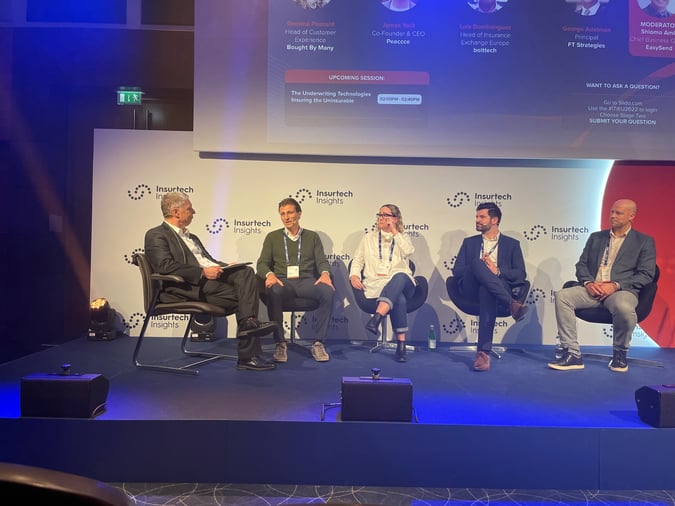Good content or products alone no longer guarantee success. The digital customer journey must deliver meaningful value at each step if companies want to attract, convert and keep customers over the long run.
-
George Adelman
A promising start
One of the promises of digitalisation has been a revolution in efficiency. Digital transformation provides opportunities to more flexibly integrate, align and automate activities and processes in a way that the manual or even the mechanised world cannot compete with. This synthesis and systematisation of data has not only brought operational benefits through - it also allows value, the things that people are interested in and care about, to be more effectively delivered throughout the customer lifecycle.
Gaining traction
It was impressive to observe at the recent Insurtech Insights conference how sectors such as Fintech continue to harness digital capabilities to make the customer journey as efficient and ‘frictionless’ as possible. At FT Strategies, however, we argue that frictionless optimisation alone should not be the end-goal. Some friction can even be a good thing - after all, friction in physics is an important force, as traction can help create momentum. In the context of a digital business, these moments of traction are customer interactions or ‘touchpoints’.





The Midas touchpoint
Touchpoints are opportunities to exchange value between you and your customers. They help to attract, engage, convert, retain, upsell and cross-sell to customers. Moreover, they help to better understand your customers in order to develop and provide more tailored and profitable solutions. The more a customer interacts with the content in your digital platform or interface, the more you can both demonstrate the value of your offering and better evaluate the things that they value.
This exhibition marked the first step in creating the “Celestial Hermitage”. According to the gallery, this is “a new museum in the virtual noosphere, which in future will be transformed into a digital branch of the actual museum”
While the metaverse and NFTs may not be the right approach for every organisation, the cultural sector is often uniquely placed to lead on future technologies. The Hermitage provides a great example of the kind of payoff that’s possible when an organisation adopts an open and experimental approach.
Touch points versus pain points
It is therefore just as important to inject value into your customer experience as it is to make it streamlined and effortless. A great example of this comes from the burgeoning video gaming industry, which has seen a CAGR of 7.2% from 2019. The gaming industry realised many years ago that there were limits to how much they could optimise the processing times when users were loading games, particularly as games became more complex and data-heavy. So instead of seeking to shorten loading times, they created content such as videos and ‘mini-games’ to enhance the user's experience whilst they wait. The process is less efficient but more enjoyable and more valuable for customers.





Products of success
One of the reasons that many industries undervalue customer experience is that they are too heavily product-focused. Often, the quality of the product provided by a company plays a secondary or even minor role in the customer’s overall experience. Taking insurance as an example, the performance of the product is often only realised in the event of the claim and yet there are countless other moments and opportunities for value exchange. In the Vitality insurance/Apple partnership, customers who buy a health or life insurance plan get a discounted Apple Watch, and in exchange for providing health data to Vitality, can earn activity points and ultimately pay lower future premiums. This symbiotic value exchange differentiates Vitality’s service offering through a valued product (the watch), health-based gamification, lower pricing and a more compelling customer experience. Furthermore, it provides Vitality with countless customer data points from which they can better design and price their products and services.
Four steps to enhance CX
To inject more value into the digital customer experience (CX), we recommend four key steps:
1. Identifying customer needs
The first and most important step to improving the customer experience is to identify and better understand who your customers are, their needs, behaviours and pain points
2. Creating customer value
Once you have identified your customer needs, you can then begin to produce or procure content, products and services that address these needs and pain points.
3. Delivering customer value
After creating the forms of engagement, companies should then consider the methods and means for enhancing the delivery and impact of these content areas, products and services
4. Measuring customer engagement
Finally, with the interactive touch points established, companies should then strive to track and quantify customer engagement in order to identify further opportunities for value exchange, conversion, renewal, upsell and cross-sell.





Partnering for value
Creating persistent and engaging content, products and services, we know well at the Financial Times, is by no means an easy task. The FT has worked hard, invested wisely and learnt many tough lessons in its journey to 1million digital subscribers and as a news publisher, content and product creation are very much our raison-d’etre.
For most companies, content creation or even regular product and/or service creation are not their primary operating activities. Where in the past these companies have sought to work with technology and digital partners to support capability building, particularly in the context of digital optimisation, going forward, we envisage a move towards partnering for value creation. This is because in the cutthroat battlefields of the attention economy, companies will need partners to enhance their customer experience and value exchange in order to keep attracting, engaging, converting and retaining customers.

.png?width=768&name=Hero%20Image%20(21).png)

